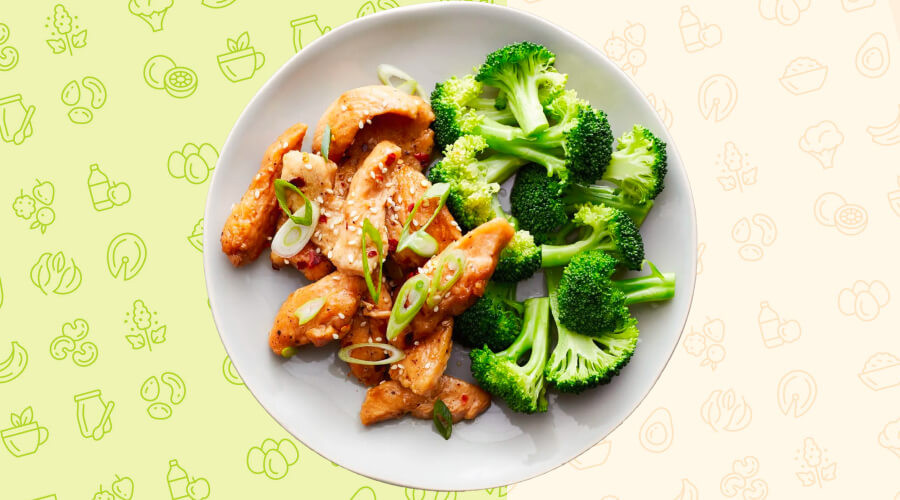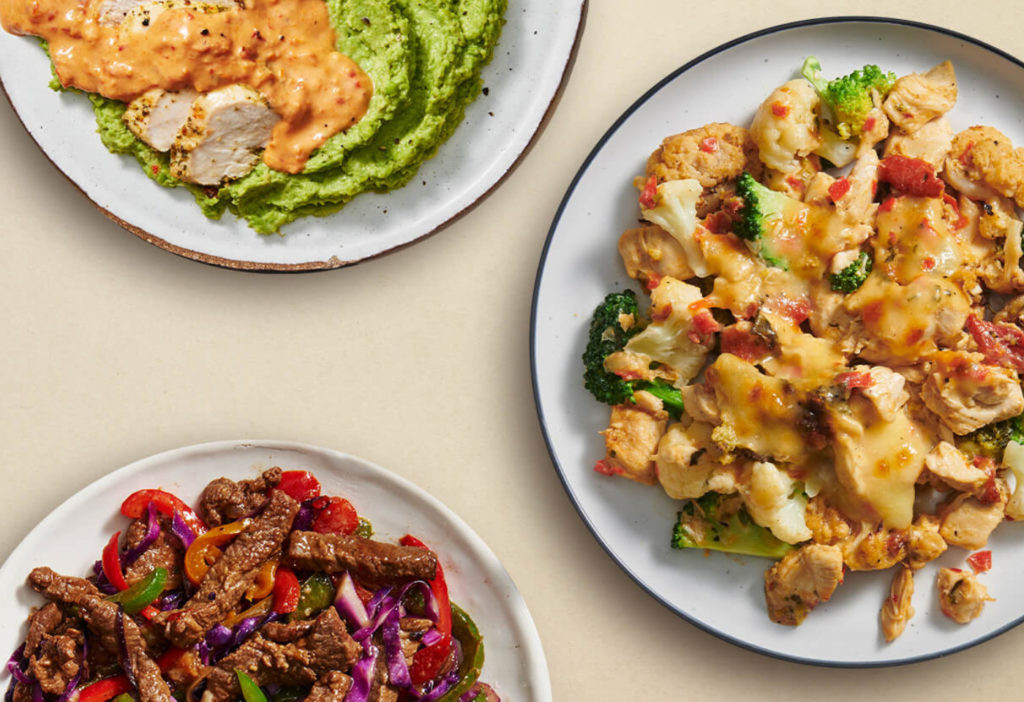You might be keen on starting a low-carb diet for various reasons. Be it weight loss or better blood sugar control; the low-carb diet can be a means of achieving various health goals.
Despite its possible benefits, it can be a little daunting to make the switch, simply because the low-carb diet sounds pretty restrictive on paper. That’s true for certain variations of this diet, such as the ketogenic diet and Atkins diets, which have set-in-stone guidelines for you to follow.
But this isn’t always the case. For some people, what works best is making small but targeted changes to their diet gradually. This is often a more sustainable approach than going all in on drastic dietary changes.
In general, a low-carb diet gives you this leeway and flexibility to set up a personalized plan that works best for your nutritional needs and lifestyle.
Of course, building a low-carb diet meal plan from scratch can still be daunting and time-consuming. So we’ve put together this low-carb meal planning guide to help you better understand the low-carb diet, including which foods are best to stock up on and which are best avoided.
We’ve also included a low-carb meal plan as a sample guide for you to get started.
How to Curate Your Own Low-Carb Diet

In this section, we’ll look at the different factors to consider when curating a personalized low-carb diet to meet your body’s needs and take you closer to your wellness goals.
How Many Carbs Should I Consume on a Low-Carb Diet?
There isn’t a strict definition of what constitutes a low-carb diet, and there’s also no one-size-fits-all approach to getting started on one.
But, in general, most people on a low-carb diet usually get 25-100 grams of carbs per day. But any diet that delivers less than 130-150 grams of carbohydrates per day could be considered low-carb.
The following are some research-backed definitions of different diets based on their carb content: [1]
- Very low-carbohydrate: Less than 10% of total calorie intake or less than 20-50 grams of carbs per day
- Low-carbohydrate: Less than 26% of total calorie intake or less than 130 grams per day
- Moderate-carbohydrate: Around 26% to 44% of total calorie intake
- High-carbohydrate: 45% or greater of total calorie intake
Research suggests that restricting your carb content to less than 50 grams per day could encourage the depletion of glycogen stores and ketone production [1]. This is what the keto diet is said to help you achieve.
How Much Protein Should I Consume on a Low-Carb Diet?
It’s natural to increase your intake of protein and fats to compensate for the reduction of carbs in your diet. But the right ratio depends on your health goals and your body’s needs.
In general, a sustainable, balanced low-carb diet should provide moderate amounts of proteins and higher amounts of fats.

There are also some low-carb diets, like the Atkins diet, that recommend taking higher amounts of both proteins and fats.
Based on the Dietary Reference Intake report for macronutrients, the current recommendation for protein requirements in adults is 0.8 grams of protein/kg of your body weight each day [2].
But many experts agree that this amount of protein might not be sufficient for many population groups.
For instance, if you’re looking for a low-carb diet that would help to promote weight loss and muscle growth, a daily protein intake of 1.0-1.6 g/kg of body weight each day is recommended. Healthy adults may consume up to 2.0g/kg per day, especially if they’re physically active [2].
How Much Fat Should I Consume on a Low-Carb Diet?
There isn’t a set amount or percentage of how much fat to consume on a low-carb diet.
In general, if you’re on a flexible low-carb diet, here’s how you can fine-tune your fat intake:
- Decide what percentage of your total calorie intake will be made up of carbs. Consuming less than 130 grams of carbs per day is a very general definition of a low-carb diet.
- Next, determine how much protein you’ll need. If you want to lose weight or build muscle, a higher protein intake of 1-2g/kg daily is recommended. You’ll need enough proteins to keep you satiated.
- Fats can be used to compensate for the reduced carbs and to add flavour to your meals. After determining your carb and protein intake goals, adjust your fat intake based on your body’s needs. If you get hungry too quickly, add more fibre and protein to your meals. You can also increase your intake of healthy fats so you’re able to keep hunger at bay.
Fats can make up 40-50% of your daily calorie intake, but this percentage may go up to 80%. In any case, what’s most important is the quality of the fats you’re consuming.
Before making any significant changes to your diet, it’s always best to seek advice from a registered dietitian or doctor, especially if you have any medical conditions.
Your Low-Carb Grocery List: Which Foods to Focus On & Which to Avoid
The types of foods that can fit into your low-carb diet or keto meals depend on your daily carb allotment.
Some of the best low-carb foods to add to your shopping list include the following:
- Proteins and some dairy products: Chicken, beef, and pork are all suitable choices for a low-carb diet. Hard-boiled eggs and fish are also high-protein and low-carb. Some dairy products, such as butter, Greek yoghurt, and cheeses like cottage cheese, Mozzarella cheese, Parmesan cheese, and goat cheese, are also fantastic options to include.
- Non-starchy vegetables: Broccoli, asparagus, Brussels sprouts, zucchini, bell peppers, and leafy greens are all veggies to include in a low-carb diet. Fibre helps with hunger management, so be sure not to skimp on your veggies on this diet.
- Lower-carb fruits: Some lower-carb fruits include raspberries, apricot, strawberries, avocados, and watermelon. Blueberries and blackberries are also decent options, though they tend to be slightly higher in carbs than strawberries.
- Healthy fats and oils: Olive oil, avocado oil, coconut oil, butter
- Seeds and nuts: Pecans, brazil nuts, Macadamia nuts, walnuts, chia seeds, flax seeds
Depending on your carb restrictions, you might be able to include legumes such as lentils and chickpeas, as well as some whole grains like oats and brown rice, into a low-carb diet.
Higher-carb fruits and starchy vegetables, like sweet potatoes, might also fit into a low-carb diet. However, if you are on a rather strict low-carb diet or keto diet, you’ll need to be cautious of your intake of these foods.
Certain foods should be limited. They include foods that are very high in sugar, such as cookies, cakes, ice cream, candy, and soft drinks, as well as highly-processed foods like potato chips.
Some brands might label their foods as low-carb or keto-friendly, but it’s best to take a good look at the nutritional label before placing these products into your shopping cart.
5-Day Meal Plan Sample Guide for a Low-Carb Diet
The following is a sample low-carb meal prep guide that delivers a total of about 40-60 grams of carbs per day.
Day 1
Breakfast:
- Bacon Omelet (2 eggs, 50 grams of diced bacon, 30 grams of cheddar cheese, mushrooms, olive oil)
- Carbs per serving: ~3 grams
Lunch:
- Beef Crunch Wrap (120 grams of lean beef, a low-carb wrap, light cheese, tomato, onions, baby spinach)
- Carbs per serving: ~26 grams
Snack:
- 2 deviled eggs (2 large eggs, mustard, mayonnaise, white vinegar)
- Carbs per serving: ~1.2 grams
Dinner:
- Beef Medallions, Saffron Rice & Green Beans (130 grams of ground beef, 25 grams of Jasmine rice, 100 grams of green beans, saffron, olive oil)
- Carbs per serving: ~27 grams
Day 2:
Breakfast:
- Low-carb pancakes (eggs, milk, almond flour, baking powder, coconut oil)
- Carbs per serving: ~6 grams
Lunch:
- Butter chicken burrito (140 grams of diced chicken, 25 grams of low-fat Greek yoghurt, 70 grams of cooked rice, low-calorie wrap, butter, tomatoes, onions, seasoning)
- Carbs per serving: ~30 grams
Snack:
- Greek yoghurt with nuts (170 grams of Greek yoghurt, 20g walnuts)
- Carbs per serving: ~6.5 grams
Dinner:
- Garlic Butter Salmon with asparagus (1 salmon fillet, heavy cream, butter, garlic, spinach, Parmesan cheese, 6 medium spears of asparagus)
- Carbs per serving: ~6.4 grams
Day 3:
Breakfast:
- Healthy breakfast burger (100 grams of lean beef, 20 grams of less-fat grated cheese, 1 medium egg, 2 slices honey leg ham, 1 low-GI bread roll, spinach, siracha)
- Carbs per serving: ~8 grams
Lunch:
- Chicken salad (60 grams of shredded cooked chicken, 60 grams of grape tomatoes, 15 grams of Parmesan cheese, 50 grams of Romaine lettuce, Caesar salad dressing, 7 grams of gluten-free or low-carb croutons)
- Carbs per serving: ~11 grams
Snack:
- Strawberry smoothie (60 grams of milk, 30 grams of Greek yoghurt, ice, 40 grams of frozen strawberries)
- Carbs per serving: ~4 grams
Dinner:
- Chimichurri Steak (125 grams of sweet potato, 150 grams of beef steak, red wine vinegar, garlic, red pepper, cumin, olive oil, cilantro, parsley, seasonings)
- Carbs per serving: ~29 grams
Day 4:
Breakfast:
- Breakfast muffins (3 eggs, 30 grams of grated cheddar, broccoli, corn, spinach, spring onion, seasonings)
- Carbs per serving: ~14 grams
Lunch:
- Big Mac Tacos (2 small tortillas, 150g extra-lean beef mince, shredded lettuce, pickles, Big Mac Coles Sauce)
- Carbs per serving: ~12 grams
Snack:
- Kale chips
- Carbs per serving: ~7 grams
Dinner:
- Creamy Chicken (150 grams of chicken breast, chopped spinach, 60ml low-fat milk, 1.5 servings of Light Laughing Cow Cheese, 7.5 grams of light cheddar cheese, 35 grams of cooked rice, Chipotle sauce)
- Carbs per serving: ~19 grams
Day 5:
Breakfast:
- 2 hard-boiled eggs
- Carbs: ~1.2 grams
Lunch:
- Chicken Burrito Bowl (150 grams of Chicken Breast, 35 grams of low-fat Greek yoghurt, 30 grams of cooked Mexican-style rice, diced tomatoes, diced onions, corn, black beans, seasonings)
- Carbs per serving: ~35 grams
Snack:
- Cottage cheese with strawberries (1/2 cup of cottage cheese, 2-3 sliced strawberries, or any other nuts or berries of your choice)
- Carbs per serving: ~7 grams
Dinner:
- Grilled chicken with Brussels sprouts and Cauliflower rice (150 grams of chicken breast, 80 grams of Brussels sprouts, 85 grams of cauliflower rice, seasonings)
- Carbs per serving: ~13 grams
The above is a general guideline to help you get started with meal planning for a low-carb diet. Feel free to modify it based on your preferences and your body’s needs.